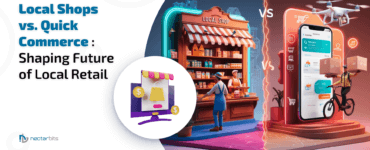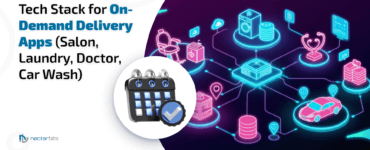Rewind your tape to the time before corona hits the world- the retail industry was rewriting the rules. The retail brick-and-mortar stores were investing heavily into modernizing and organizing the store by warmly embracing advanced technologies. Alas! After the pandemic, the retail industry is bleeding due to recession, restricted movement of the people, and high rentals and maintenance charges.
When the lockdown lifts, the brick-and-mortar stores have brought gala changes- wearing masks, social distancing, contactless transactions, and self-service options to keep the store running. However, it’s not enough, the retailers need to complement the offline store with the Ecommerce store to deliver the consistent digital experiences that customers are expecting.
Moreover, the customers have stopped tolerating sub-par experiences that they compromised with during complete lockdown. The grocery retailers need to make significant changes to the digital channels to create a fortune, build a great future, and play catch up with established players like- Amazon, Target, and others.
Read More: Customizable Platform To Launch an eCommerce Store Multi-Vendor Marketplace Development Solution.
Here are a couple of strategies that allow grocers to engineer future-proof Ecommerce stores.
Build fulfillment space
For small grocery stores, it’s difficult to create dedicate fulfillment centers for Ecommerce orders because it’s an expensive endeavor. Till now, the in-store workers select the ordered product from shelves, pack them, and make it available to the inventory, which is not a good deal.
Read more : Types Of E Commerce Business Models
The best thing for small retailers is to encourage in-store operations alongside keeping a space for order assembling and product staging. It gives the flexibility to the grocery stores to swing by and grab their prepaid orders when it’s convenient for the customers. Although warehousing on-site is a good way to accelerate the delivery operations as compared to in-store or curbside pick-up options.
Automate warehouse operations but strategically
With astronomical rise in Ecommerce sales, the number to choose and pack from the store and warehouse in increased by an equal amount. However, it needs to be fulfilled at speed, which is implausible with manual operations. The stores are planning to incorporate automation in the warehouse while keeping growth projections in mind. Although it works only when the store has the strategy in place.
The robots will fix the short-term problem and bring profits in long term. However, the grocery businesses are recommended to hold on for a while to see if the Ecommerce venture stays in a profitable state in the years to come. Also, the robots are expected to become inexpensive the next year. The best way is to invest in robots and strategy when it’s appropriate.
Read more : Why the F&B Industry Needs E-Commerce website
Listen to the customers to go the extra mile
Amidst logistical and technical challenges accompanied by scaling Ecommerce operations, the grocers had a great opportunity to build a rapport with customers. In times of uncertainty, the retailers don’t what the future holds, but they know their customers, their expectations, and can listen to them. It helps in better connecting with the customers.
For instance, when the product is out-of-the-stock or the problem of finding a delivery window pops up unexpectedly, it’s better to inform the customers and provide them alternate options, which help in engaging them. The innovation in fostering two-way customer interactions enhances the experience too.
Sync online and offline operations to deliver consistent experience everywhere
Undoubtedly, the grocers are continuously upgrading the online experience to wow the customers. The in-store experience lacks the appeal that an online store is providing. The grocery stores need to improve the in-store experiences too because the customers expect consistent experiences on both online and offline channels.
For instance, the shoppers expect accurate information about products, offers, alternative suggestions when the product is out of stock, irrespective of the shopping channel they are choosing, be it in-store or online. This has become the expectation of the customers on the minimum side.

Plus, rendering the physical grocery store shopping experience virtually is essential as the customers have accustomed to in-store shopping especially grocery shopping. In addition to syncing the online and offline experiences, consider revising generic experiences when customers reach your digital door to stay on the top of their minds always.
Innovate the marketing tactics to stay incredible
Online grocery shopping has gone mainstream, but getting your grocery store ahead of the pack requires you to market the store tactically. The store depending on traditional marketing, they are also increasing the investments in digital marketing to increase customer outreach, conversion, and ROI. The retailers need to create a strategy that works for both offline and online stores.
For instance, the retailer has published the biscuit recipes, then the ingredients must be available at online stores and brick-and-mortar stores. The omnichannel marketing tactics benefit the retailers in total.
Taste the freshness before it reaches the doorstep
With emerging technologies taking a step into the digital world, the retailers are rendering virtual experiences online of the offline stores. for instance, through VR technology, the simulated experiences of butcher shops of Italy are experienced by the customers. The selected items are added to the list and then delivered to the customers’ doorstep.
Moreover, the health freaks a little susceptible to food quality, which is generally experienced in urban areas. Hershey attempted moving containers that are tested by food experts would be a draw to this problem.
Make the delivery flexible
During checkout, everything is clear to the customers, be it- shipping options, shipping cost, delivery restrictions, and pretty more. To keep up with the customers, several delivery options and time slots are provided that fit best with the people looking for delivery time slots and other specifications.
Especially, the grocers are experimenting with delivery options when they have to deliver the food globally. The delivery options depend upon the food type (Require temperature and pressure maintenance), customers’ demand, competition, and preferred delivery alternative- doorstep delivery or pick-up. For such deliveries, the grocers need to have the necessary infrastructure in place so that products are distributed at the right time and right place.
Wrapping it up
The future is unpredictable. But the upward growth in online grocery shopping post-pandemic is expected to continue in the future ahead. It signals, the retailers don’t try out of the storm with a digital channel; instead, they should work proactively with digital transformation to better serve the customers and delivering the out-of-box experience. The strategies would help them adapt to modern customers’ demands and get prepared for the new age of Ecommerce prudently.









